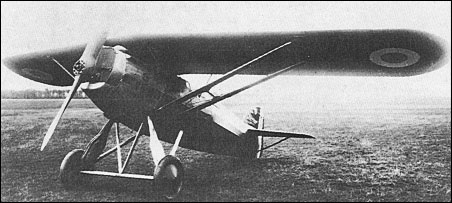|
| As a direct result of concern over the escalating costs of
fighter manufacture, a programme for the development
of so-called chasseurs legers, or light fighters, for
France's Aviation Militaire was promoted in 1926. To
become known unofficially as the Jockey programme,
this envisaged the use of moderate power, minimal
equipment and a pair of 7.7mm Vickers guns with only
300 rounds each. Emphasis was to be placed on climb
rate, an endurance of one-and-a-half hours at full throttle
was called for and a ceiling of 8000m was
specified. To meet this requirement, Morane-Saulnier
designed and built its first post-World War I fighter, the
MoS 121, the prefix being changed to M.S. shortly after
the appearance of the prototype in 1927. Possessing
lower wing and power loadings than other contending
designs (with the exception of the M.S.221 developed in parallel, the M.S.121 was a single-seat parasol monoplane
of mixed construction and powered by a 465hp
Hispano-Suiza 12Jb 12-cylinder water-cooled engine. It
proved underpowered and incapable of attaining specified
climb rates, and was, in consequence, discarded in
favour of the more powerful M.S.221.
 | A three-view drawing (1280 x 826) |
| WEIGHTS |
| Take-off weight | 1276 kg | 2813 lb |
| Empty weight | 1011 kg | 2229 lb |
| DIMENSIONS |
| Wingspan | 9.80 m | 32 ft 2 in |
| Length | 6.72 m | 22 ft 1 in |
| Height | 2.88 m | 9 ft 5 in |
| Wing area | 16.00 m2 | 172.22 sq ft |
| PERFORMANCE |
| Max. speed | 257 km/h | 160 mph |
|
Do you have any comments?
|
| 
COMPANY
PROFILE
All the World's Rotorcraft
|







